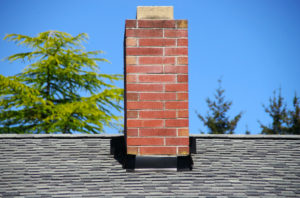There’s nothing quite like a crackling fire in your fireplace on a cold, snowy winter’s night. If you have a working fireplace, you’re surely the envy of your neighbors at this time of year. Many homes have fireplaces, but if you don’t take care of your chimney, they aren’t safe to use. Chimney fires a real threat, and they cause more than 125 million dollars in property damage annually. Today, we’ll explain how chimney fires start.

Chimney fires cause more than 125 million dollars in property damage annually. This is how they start.
The Culprit: Creosote
In the overwhelming majority of chimney fires, the source of the problem is creosote. We’re sure you’ve heard this word before and are generally familiar with the concept. But what exactly is creosote, anyway?
Essentially, creosote is a byproduct made by burning wood. It consists mostly of tar. As time goes on and you’re lighting fires in your fireplace, creosote will gradually build up along the ‘walls’ of your chimney. As you might have guessed, this substance is extremely flammable.
Keep in mind, though, that there are a few steps you can take to reduce creosote build-up in your chimney. Chief among them is using perfectly dry, seasoned firewood. This will reduce the frequency at which your chimney needs to be swept.
If you’re curious how chimney fires start, the answer is almost always creosote.
Signs of a Chimney Fire
You may think that it would be obvious if you had a chimney fire. In fact, it’s not always as apparent as you might think. Still, having a good sense of the signs of a chimney fire is crucial to your ability to call the fire department and experience minimal damage to your home.
This might surprise you, but one of the first signs of a chimney fire is often the smell. If you’ve noticed bad smells coming from your chimney in the past, this may have been caused by excess creosote. Creosote smells strongly when it is burning, too, so any strange smells during a fire could alert you that something is up.
Use your sense of sound, too. Beyond the typical popping or crackling noises you associate with fires, you may also hear what sounds almost like a plane’s engine coming from your fireplace. This is another telltale sign of a chimney fire.
Finally, use your sense of sight. Step outside and look at your chimney. If you see flames leaping out the top of your chimney or even excess smoke, call the fire department as soon as you can.
What Can I Do About It?
We hope that you never experience a chimney fire. The good news is that you don’t have to. With proper chimney maintenance, you can reduce the risk of chimney fires to almost zero.
The secret to avoiding them is to remember how chimney fires start: creosote. Creosote build-up may be inevitable, but how you respond to it is in your hands. When you have your chimney swept, they clean the creosote out of your chimney, dramatically reducing the threat of a fire.
As a rule of thumb, you should have your chimney swept once per year. Heavy fireplace users may need to do so more often. For your chimney sweeping needs, Champion Chimneys is here to help!
Call the Experts at Champion Chimneys for Chimney Sweeping Today!
Champion Chimneys, Inc. is a fully licensed, bonded and insured chimney service company that has served customers in Baltimore County, Howard County, and Anne Arundel County, Maryland since 2001. Our team is trained and certified by Certified Chimney Professionals, Inc. (CCP, Inc.). Courteous service is our trademark, and our crews arrive on time in uniform, driving fully equipped trucks. We specialize in all aspects of your chimney system. Whether you need chimney and flue cleaning service or a full chimney rebuild or inspection, contact us at 443-Chimney today and let us fix all your chimney problems. Also, follow us on Facebook, Twitter, LinkedIn, and Pinterest.
